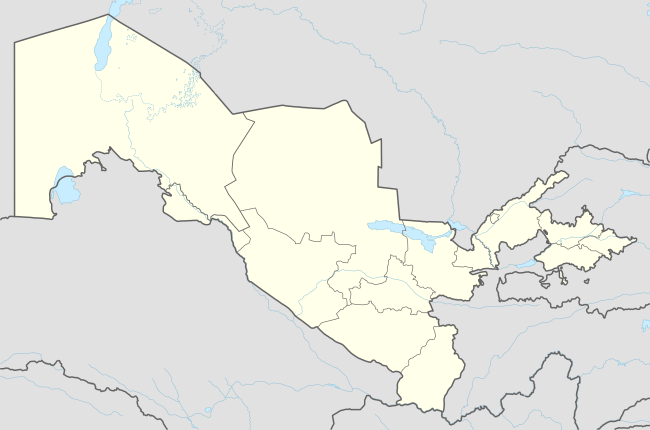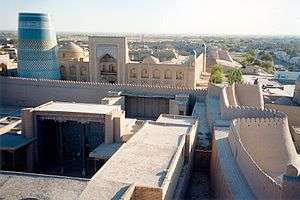Khiva
| Khiva Xiva / Хива | |
|---|---|
|
Walls of Itchan Kala | |
 Khiva Location in Uzbekistan | |
| Coordinates: 41°23′N 60°22′E / 41.383°N 60.367°E | |
| Country |
|
| Region | Xorazm Region |
| Population (2004) | |
| • Total | 51 200 |
Khiva (Uzbek: Xiva/Хива, خىۋا; Persian: خیوه, Xīveh; Russian: Хива; alternative or historical names include Khorasam, Khoresm, Khwarezm, Khwarizm, Khwarazm, Chorezm, and Persian: خوارزم) is a city of approximately 50,000 people located in Xorazm Region, Uzbekistan. According to archaeological data, the city was established in the beginning of the Christian era.[1] It is the former capital of Khwarezmia and the Khanate of Khiva. Itchan Kala in Khiva was the first site in Uzbekistan to be inscribed in the World Heritage List (1991).
Etymology
The origin of the name Khiva is unknown, but many contradictory stories have been told to explain it.
A traditional story attributes the name to one of the sons of Noah: "It is said that Shem [from whence the word Semitic is derived], after the flood, he found himself wandering in the desert alone. Having fallen asleep, he dreamt of 300 burning torches. On waking up, he was pleased with this omen, he founded the city with outlines in the form of a ship mapped out according to the placement of the torches, about which he had dreamt. Then Sim dug the 'Kheyvak' well, the water from which had a surprising taste. It is possible to see this well in Ichan-Kala (an internal town of Khiva City) even today."[2]
Another story relates that travellers passing through the city, upon drinking the excellent water, would exclaim "Khey vakh!" ("What a pleasure!") and hence the city became known as Kheyvakh, whence Khiva.
A third proposal is that the name comes from the word Khwarezm, altered by borrowing into Turkic as Khivarezem, then shortened to Khiva.
History

- For further history of Khiva and the Khanate of Khiva, see: Khwarezm
In the early part of its history, the inhabitants of the area were from Iranian stock and spoke an Eastern Iranian language called Khwarezmian. Subsequently the Iranian ruling class was replaced by Turks in the 10th century A.D, and the region gradually turned into an area with a majority of Turkic speakers.
The city of Khiva was first recorded by Muslim travellers in the 10th century, although archaeologists assert that the city has existed since the 6th century. By the early 17th century, Khiva had become the capital of the Khanate of Khiva, ruled by a branch of the Astrakhans, a Genghisid dynasty.
In 1873, Russian General Konstantin von Kaufman launched an attack on the city, which fell on 28 May 1873. Although the Russian Empire now controlled the Khanate, it nominally allowed Khiva to remain as a quasi-independent protectorate.
Following the Bolshevik seizure of power after the October Revolution, a short lived Khorezm People's Soviet Republic was created out of the territory of the old Khanate of Khiva, before its incorporation into the USSR in 1924, with the city of Khiva becoming part of the Uzbek Soviet Socialist Republic.
Sights
.jpg)
Khiva is split into two parts. The outer town, called Dichan Kala, was formerly protected by a wall with 11 gates. The inner town, or Itchan Kala, is encircled by brick walls, whose foundations are believed to have been laid in the 10th century. Present-day crenellated walls date back to the late 17th century and attain the height of 10 meters.
The large blue tower in the central city square was supposed to be a minaret, but the Khan died and the succeeding Khan did not complete it.
The old town retains more than 50 historic monuments and 250 old houses, mostly dating from the 18th or the 19th centuries. Djuma Mosque, for instance, was established in the 10th century and rebuilt in 1788-89, although its celebrated hypostyle hall still retains 112 columns taken from ancient structures.

Photo gallery
Sister cities
See also
References
- ↑ В. А. Булатова, И. И. Ноткин, Архитектурные памятники Хивы. (Путеводитель), Ташкент, 1972; Хива. (Архитектура. Фотоальбом), Л., 1973; Г. Пугаченкова, Термез, Шахрисябз, Хива, (М„ 1976).
- ↑ Nashriyoti, Davr (2012). Khiva: The City and the Legends. Tashkent, Uzbekistan: DAVR NASHRIYOTI LLC. p. 2. ISBN 9789943339262.
Publications
- Campaigning on the Oxus, and the Fall of Khiva, MacGahan, (London, 1874).
- A Ride to Khiva, Frederick Burnaby, (OUP, 1997. First published 1876).
- Russian Central Asia, Lansdell, (London, 1885).
- A travers l'Asie Centrale, Moser, (Paris, 1886).
- Russia against India, Colquhoun, (New York, 1900).
- Khiva, in Russian, S. Goulichambaroff, (Askhabad, 1913).
- A Carpet Ride to Khiva, C. A. Alexander, (London, 2010).
- Journey to Khiva, Philip Glazebrook, A Writer's Search for Central Asia, (London, 1992).
External links
| Wikimedia Commons has media related to Khiva. |
 Khiva travel guide from Wikivoyage
Khiva travel guide from Wikivoyage- Images and travel impressiones along the Silk Road - Khiva
Coordinates: 41°23′N 60°22′E / 41.383°N 60.367°E











